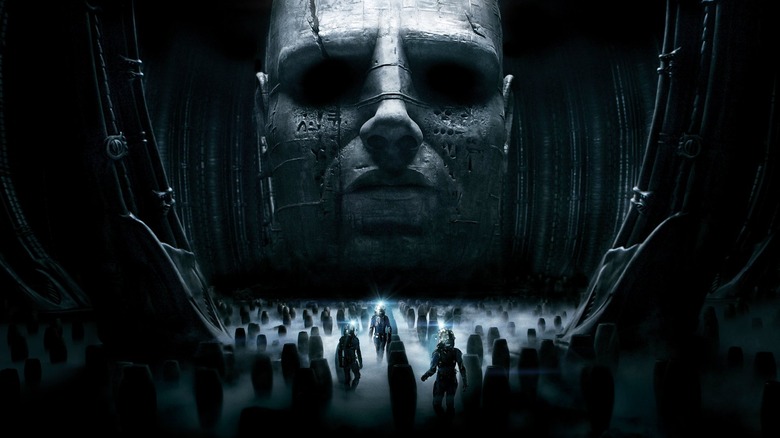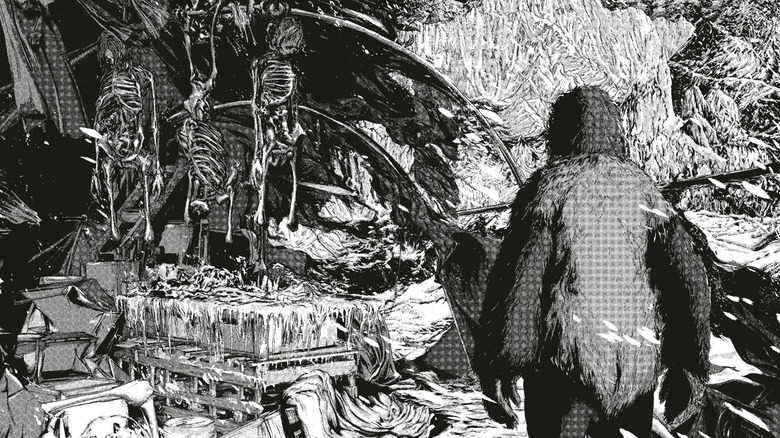The Sci-Fi Movie That Killed Guillermo Del Toro's At The Mountains Of Madness Adaptation
There's no movie I'm more excited for in 2025 than Guillermo del Toro's "Frankenstein." The sumptuous-looking trailer hints that del Toro's "Frankenstein" could be the truest adaptation yet of Mary Shelley's "The Modern Prometheus," but it's also unmistakably his movie; he considers this to be part of a thematic trilogy with "Nightmare Alley" and "Pinocchio."
Del Toro is one of the foremost fantasy and horror directors we have working today. "Frankenstein" will bring him back to directing outright science-fiction for the first time since 2013's "Pacific Rim." ("The Shape of Water" may have a fish man as a lead character, but it's definitely more of a fairy tale than sci-fi.)
Besides "Frankenstein," there's another classic sci-fi story that del Toro has long wanted to adapt: H.P. Lovecraft's "At The Mountains of Madness." Published in 1936 (shortly before Lovecraft's death), the story follows a university research team in Antarctica. When some of the explorers are found brutally murdered, geologist William Dyer and his student Danforth investigate and come across a prehistoric city, home to many-angled Elder Things (also known as Elder Ones) that walked Earth about a billion years before human civilization sprouted up. The Elder Things' civilization was destroyed by the shoggoths, a thrall race of shapeshifters they created that rose up against them. Dyer and Danforth survive (the novella's events are recounted in first person by Dyer), but Danforth is driven irrevocably insane.
Guillermo del Toro had been trying to make "At The Mountains of Madness" since the early 2000s, but found no home for it at Warner Bros. In 2010, he managed to make progress on it at Universal; James Cameron (who first read "Alita" thanks to his friendship with del Toro) would produce and Tom Cruise was the top pick to star. Then, the movie again fell apart due to budget concerns and del Toro refusing to budge on having an R rating.
Del Toro has a ton of unrealized projects, from a live-action adaptation of Naoki Urasawa's manga "Monster," to a third "Hellboy" movie. For a while, his "Frankenstein" had dropped into development hell. "At The Mountains of Madness" remains something that del Toro fans want to see, especially after del Toro shared some CGI test footage from the project in 2022.
But there's another reason the filmmaker stopped trying to make "At The Mountains of Madness" after the 2011 cancellation. The following year, another science-fiction movie came out with a similar premise: Ridley Scott's "Alien" prequel, "Prometheus."
Prometheus brings the chariots of the gods to the mountains of madness
On April 30, 2012, shortly before the release of "Prometheus" that June, del Toro posted on the Del Toro Films forum that the movie "will probably mark a long pause — if not the demise — of ['At The Mountains of Madness']."
"'Prometheus started filming a while ago — right at the time we were in pre-production on 'Pacific Rim.' The title itself gave me pause knowing that 'Alien' was heavily influenced by Lovecraft and his novella. This time, decades later with the budget and place Ridley Scott occupied, I assumed the Greek metaphor alluded at the creation aspects of the HPL book."
Now that "Prometheus" is long-released, it's clear del Toro was right on the money. Scott's film is set in the early 22nd century and follows astronauts tracking archaeological clues of an ancient civilization on Earth. They arrive at the planet LV-223, which holds an ancient structure built by the alien Engineers, the creators of the human race. But the Engineers' intentions towards their children are not so benevolent and the secrets in their temple were better left buried. As the tagline for "Prometheus" states: "The search for our beginning could lead to our end."
Scott and "Prometheus" writer Damon Lindelof were pulling from the 1968 book "Chariots of the Gods?" by Erich von Däniken, the root of the "Ancient Astronauts" theory that humans were uplifted by alien visitors in prehistory. But there's a lot of Lovecraft in "Prometheus," too. The whole premise of researchers investigating an ancient alien city is right out of "At The Mountains of Madness."
Creation of life is also a key theme in both stories; the Engineers created us just as the Elder Ones created the shoggoths. The Engineers are a lot more comprehensible than Lovecraft's tentacled monsters — they look like tall, pale, bald humans and are just as mortal as we are. While the Elder Ones and their civilization completely defy understanding, the Engineers are insinuated to be not too different from their offspring. They experimented with forces beyond their ability to dominate and now want to cleanse the failed experiment that is Earth. What's scarier, an incomprehensible void of madness or knowing and understanding that us humans have no more divine heritage than lab rats?
Will Guillermo del Toro's At The Mountains of Madness ever be made?
The big and obvious difference is that "Prometheus" is set in space. That means there's a degree of removal for the horror, whereas "At The Mountains of Madness" is all about horrible secrets buried in our world. When Lovecraft wrote the story in the 1930s, Antarctica was still only barely explored. As Gou Tanabe's "At The Mountains of Madness" manga adaptation describes:
"Although larger than Europe or Australia, the very existence of the Antarctic continent remained unconfirmed until the 19th century [...] Forbidding and remote, the last of the continents to be discovered remained barely trod upon for decades. Then, just as the 19th century drew to a close, a series of daring expeditions by teams from several different nations captured the attention of the world's newspapers, as they explored the seas, coasts, and interior of Antarctica."
Lovecraft wasn't the first or last storyteller to depict Antarctica as a land of frozen horror. He pulled from Edgar Allan Poe's 1838 novel "The Narrative of Arthur Gordon Pym of Nantucket," which features its lead finding great horror at the South Pole. In 1938, author John W. Campbell published a short story "Who Goes There?" about an Antarctic outpost attacked by a shapeshifting monster. Decades later, that story became the source material for John Carpenter's classic movie "The Thing."
Could del Toro have been the next master to leave his mark on Antarctic horror? He's mostly a romantic filmmaker that loves his monsters, but when del Toro wants to, he can make terrifying beasts: the tooth fairies in "Hellboy," the Pale Man in "Pan's Labyrinth," the red ghosts in "Crimson Peak," etc. The endings of "Pan's Labyrinth" (a movie so good it inspired a Paramore music video) and "Nightmare Alley" are also quite grim. As cuddly a guy as del Toro appears to be, I doubt he'd water down Lovecraft's bleakness in making "At The Mountains of Madness."
After "Frankenstein," will "At The Mountains of Madness" be the next del Toro passion project to rise from the dead? "Prometheus" is old news by now, and Ridley Scott has no more "Alien" movies coming. If del Toro was sharing the test footage from it back in 2022, then I don't doubt his heart is still in it. It probably just depends on if Netflix is more supportive than Warner Bros. and Universal.
Guillermo del Toro's "Frankenstein" is set for release on Netflix in November 2025.


